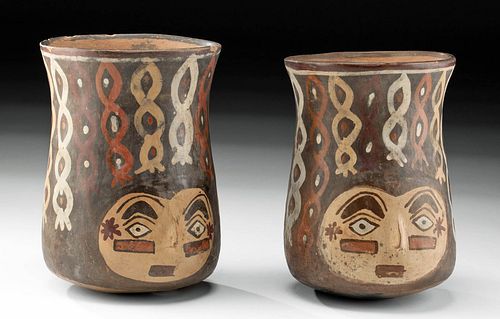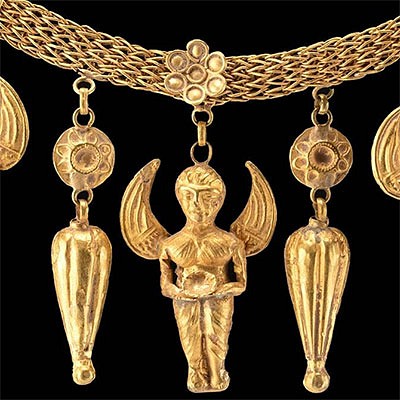Matched Pair of Nazca Polychrome Keros w/ Trophy Heads
Lot 107b
About Seller
Artemis Gallery
686 S Taylor Ave, Ste 106
Louisville, CO 80027
United States
Selling antiquities, ancient and ethnographic art online since 1993, Artemis Gallery specializes in Classical Antiquities (Egyptian, Greek, Roman, Near Eastern), Asian, Pre-Columbian, African / Tribal / Oceanographic art. Our extensive inventory includes pottery, stone, metal, wood, glass and textil...Read more
Estimate:
$1,600 - $2,400
Absentee vs Live bid
Two ways to bid:
- Leave a max absentee bid and the platform will bid on your behalf up to your maximum bid during the live auction.
- Bid live during the auction and your bids will be submitted real-time to the auctioneer.
Bid Increments
| Price | Bid Increment |
|---|---|
| $0 | $25 |
| $300 | $50 |
| $1,000 | $100 |
| $2,000 | $250 |
| $5,000 | $500 |
| $10,000 | $1,000 |
| $20,000 | $2,500 |
| $50,000 | $5,000 |
| $100,000 | $10,000 |
| $200,000 | $20,000 |
About Auction
By Artemis Gallery
Dec 3, 2020
Set Reminder
2020-12-03 10:00:00
2020-12-03 10:00:00
America/New_York
Bidsquare
Bidsquare : Fine Antiquities, Ethnographic & Fine Art
https://www.bidsquare.com/auctions/artemis-gallery/fine-antiquities-ethnographic-fine-art-6119
Features classical antiquities, ancient and ethnographic art from cultures encompassing the globe. Egyptian, Greek, Roman, Etruscan, Near Eastern, Asian, Pre-Columbian, Native American, African / Tribal, Oceanic, Spanish Colonial, Russian, Fine Art, so much more! All legally acquired, legal to sell. Artemis Gallery info@artemisgallery.com
Features classical antiquities, ancient and ethnographic art from cultures encompassing the globe. Egyptian, Greek, Roman, Etruscan, Near Eastern, Asian, Pre-Columbian, Native American, African / Tribal, Oceanic, Spanish Colonial, Russian, Fine Art, so much more! All legally acquired, legal to sell. Artemis Gallery info@artemisgallery.com
- Lot Description
Pre-Columbian, South Coast Peru, Nazca culture, ca. 100 to 400 CE. A fascinating matched pair of polychrome keros (drinking vessels) with polychrome motifs and anthropomorphic faces. The keros rest on slightly rounded but stable bases with tall walls that rise upward and flare slightly outward at the rim. The exterior is painted with an interlacing motif in beige white, orange, and plum tones. The face is situated near the base with a protruding nose and a surprised expression with painted tattoos on the cheeks. These keros were used for drinking the fermented maize beer known as chicha in ritual ceremonies or when establishing an agreement. In Nazca culture - and other ancient Peruvian cultures - the decapitation and ritual use of human heads was common practice; many mythical figures and kings known from Nazca pottery are shown holding trophy heads or in the presence of trophy heads. Drinking from these keros would certainly be proud display of past victories! Size: 4.25" W x 6" H (10.8 cm x 15.2 cm)
These keros would have been used to give an offering of chicha (corn beer) in a grave, where the vast majority of known Nazca pottery has been found. In ancient Peru, corn was not the staple food stuff that it was in Mesoamerica; instead, it seems to have mainly been used to make chicha and, possibly, a stronger hallucinogenic brew when combined with cactus juice. The Nazca linked trophy heads with corn - sometimes even portraying exposed ears of corn as trophy heads - because they believed that the taking of heads provided the necessary supernatural power to allow agricultural crops to grow. Archaeological evidence from the 20th century shows that the stylized trophy head form so common to Nazca artwork was based on real rituals. Over one hundred mummified trophy heads have been found from Nazca excavations, almost all with a puncture to the front of the skull for suspension. Archaeologists specializing this culture continue to argue over the significance of these heads in Nazca culture. The artwork here is an intriguing reminder of this ancient culture.
Provenance: private Santa Fe, New Mexico, USA collection; ex-Mary Bert Gutman collection, Philadelphia, Pennsylvania, USA, acquired in the 1950s
All items legal to buy/sell under U.S. Statute covering cultural patrimony Code 2600, CHAPTER 14, and are guaranteed to be as described or your money back.
A Certificate of Authenticity will accompany all winning bids.
We ship worldwide and handle all shipping in-house for your convenience.
#160990Nicks and chips to rim. Abrasions to surfaces and noses, with fading of pigment in some areas. Magnesium deposits and vibrant pigments.Condition
- Shipping Info
-
All shipping is handled in-house for your convenience. Your invoice from Artemis Gallery will include shipping calculation instructions. If in doubt, please inquire BEFORE bidding for estimated shipping costs for individual items.
-
- Buyer's Premium



 EUR
EUR CAD
CAD AUD
AUD GBP
GBP MXN
MXN HKD
HKD CNY
CNY MYR
MYR SEK
SEK SGD
SGD CHF
CHF THB
THB
















